
Self Improvment.pdf
- 1. How to Motivate Yourself: 3 Tips for Self Improvement 1. Put your goal on the calendar. One way to give a boost to your internal motivation is to create some external motivation: a target date. Whatever it is you’re aiming to accomplish, put it on the calendar. You may be working toward a goal with a set finish date built in. Examples include preparing for a test or taking a course with a fixed end date. If your goal lacks this structure, you can add it by deciding on a date by which you could realistically achieve your goal. Want to run a 5k or marathon? Sign up for a race on or near your target date. Considering a degree? Research the application deadline and write it down. Aiming to learn a new career skill? Register for a course and set a target date to finish. Having a target date not only helps you stay motivated, it also helps you track your progress—you always know how much further you have to go. This can have a big impact on your performance WATCH THIS MOTIVATIONAL VIDEO:https://uii.io/motivational-496 2. Make working toward your goal a habit. When you make working toward your goal a habit—an automatic conditioned response—you no longer have to rely so much on feeling motivated. How do you turn a behavior into a habit? Identify a trigger.
- 2. Choose something that you already do everyday, like brushing your teeth or eating lunch, to be a trigger for the action you want to make a habit. Write out an “if-then” plan (also known as an implementation intention). For example, if you want to create a habit of studying for a class everyday, your if-then plan might look like this: If I pour my first cup of coffee, then I will spend five minutes on my math homework. To build consistency in exercise, it might look like this: If I get up and brush my teeth, then I will immediately put on my workout clothes. Making this plan and committing it to writing could increase the likelihood of following through [3].Start small.Notice that the above examples do not say that you’ll read six chapters of your textbook, watch two hours of lecture videos, or spend an hour sweating on the treadmill.Getting started is often the hardest part on low-motivation days, and starting is much easier when the task is small: Five minutes of study or putting on your workout clothes [4]. These seemingly small actions can prime your mind for the task at hand, so the followthrough—a longer study session or a full workout—can happen more naturally with less mental resistance, according to The Science of Self Help WATCH THIS MOTIVATIONAL VIDEO:https://uii.io/motivational-495 3. Plan for imperfection.
- 3. It’s great to feel excited and confident about achieving your goal, but it’s also possible to be too optimistic [6]. Not every day will go exactly as planned, and that’s okay. Life happens. One way to boost motivation on difficult days is simply to plan for them. As you think about your goal, jot down a list of the things that could get in your way. If you’re taking an online course, this could include: ● Losing internet access ● Getting a phone call in the middle of a study session ● Having a child home sick ● Feeling stuck on a difficult concept or assignment If your goal is to go running everyday, some obstacles might include: ● Rainy weather ● Injury ● Illness ● Getting asked to stay late at work during the time you usually run We can’t predict everything that could happen, but we can predict those obstacles that are likely to happen from time to time based on our unique circumstances. Once you have your list, make a plan for how to handle the obstacle. How can you plan ahead for when your internet goes out? Maybe you could keep a few lecture videos downloaded to your phone or computer for offline access, or you could identify a nearby coffee shop that offers free wifi. Now when that obstacle pops up, instead of losing motivation and feeling deflated, you have a plan in place to keep the momentum going. Keep in mind that for some obstacles, missing your task is a perfectly acceptable plan. WATCH THIS MOTIVATIONAL VIDEO:https://youtu.be/KjJXB2Zkxgo
- 4. The WOOP method Next time you’re setting a goal for yourself, practice the WOOP technique, pioneered by Dr. Gabriele Oettingen. This stands for Wish, Outcome, Obstacle, and Plan. What is your wish? What would be the outcome of that wish coming true? What main obstacle stands in your way? What can you do to overcome that obstacle? These seemingly small actions can prime your mind for the task at hand, so the followthrough—a longer study session or a full workout—can happen more naturally with less mental resistance, according to The Science of Self Help